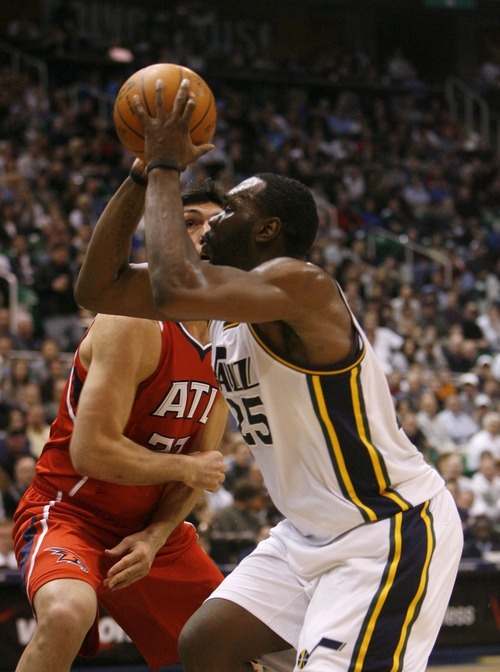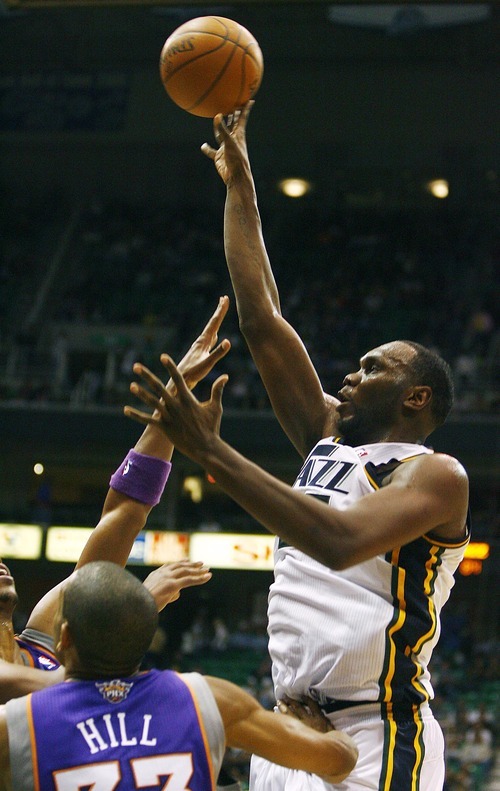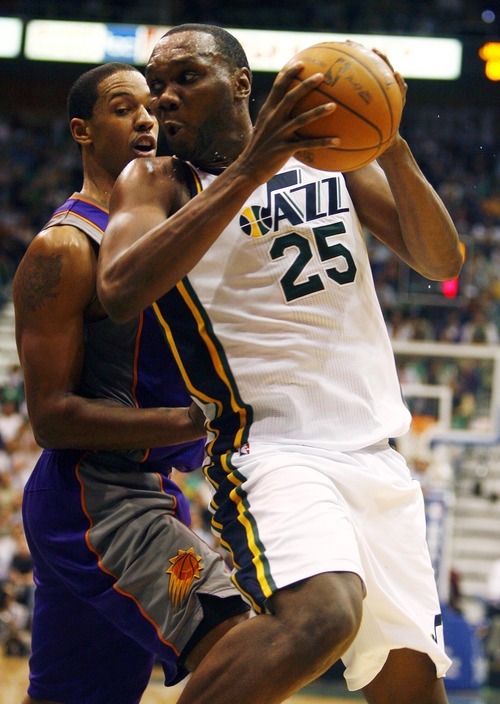This is an archived article that was published on sltrib.com in 2012, and information in the article may be outdated. It is provided only for personal research purposes and may not be reprinted.
Al Jefferson's best moves have been blatantly and proudly stolen. The rest have either been borrowed or adapted, or were simply God-given.
But no matter how the undersized and often out-of-position Jazz center acquired his powerful offensive weaponry, there is no doubt that he possesses some of the most unique and hard-to-defend post moves in the game.
The 6-foot-10, 280-pound Jefferson appears in person neither as tall nor as large as records indicate. And it is precisely his lack of height and size that have forced him to rely upon everything from an unforgiving, highly tempting pump fake to a variety of back-to-the basket, spin-and-roll sets as he has evolved from a straight-out-of-high-school standout into one of the most productive post players in the league during the last seven years.
"Ain't too many people out here in the league right now that kind of got that old-school game like I have it," said Jefferson, who grew up idolizing Hakeem Olajuwon and Shaquille O'Neal.
He added: "It kind of makes me feel good. I'm a unique player. Everybody, when they hear my name, they know what type of game I got."
To develop that game, Jefferson initially had to steal, borrow and learn from the best.
The first inside tip was provided by Boston coach Doc Rivers. It was 2004, just before Christmas during Jefferson's rookie year. Rivers noticed Jefferson's raw, still-unformed talent. But he also saw something special.
Fast, solid footwork; a low center of gravity; and a soft touch. A name and a game immediately came to mind: Moses Malone.
Rivers asked Jefferson if he was familiar with the three-time NBA Most Valuable Player who many now use as a reference point for Minnesota's Kevin Love. Jefferson was, but barely. Soon, Rivers produced a video chronicling Malone's legendary career.
"I've still got that DVD to this day," Jefferson said. "I watched it, and I was like. 'Wow.' He reminded me of myself. And I'm pretty sure Doc would say I reminded him of Moses Malone."
In a sign of just how malleable Jefferson was during his initial run in the league, his two main trademark moves also came from former Celtics teammates.
Ask Jefferson where he discovered his calling card — a smooth but vicious high-to-low pump fake that fellow Jazz center Francisco Elson referred to as being "nasty" — and the power forward disguised as a center smiles, laughs and drops a highly familiar name: Paul Pierce.
During the first two seasons of Jefferson's career, he would join Pierce and several Boston teammates during late-night shooting sessions. Jefferson intently studied Pierce's game, picking up every advantage possible. But one move shined the brightest: his pump fake. The quick, jerking, upward ball movement bought Pierce space and time, sending a defender shooting toward the ceiling while he either throttled toward the paint or leaped backward to release a fadeaway.
Six years later, the pump fake belongs more to the student than the teacher.
Elson recalls being repeatedly coached not to fall for it when he defended Jefferson. Blazers coach Nate McMillan acknowledged that the simple fact that a reporter brought the move up during an interview meant that opposing teams were obviously wary of it.
And Jefferson said that as soon as he sees a defender's eyes dart up and down, he knows that they are telling themselves "Don't jump" — and he knows that they are done for.
"If he gives you that pump fake — even if he's in the lane — you jump, and he's up and under and he's gone," Elson said.
Jefferson's use of the move has been a gradual evolution. Working with ex-Boston and current Minnesota assistant Dave Wohl, Jefferson was slowly able to blend improved footwork and the fake with a variety of post moves. By his third year in Boston, the fake was "crazy." Then, during his first two years with the Timberwolves, it "really got crazy."
Jefferson referred to good defenders as being those who don't fall for the move, such as Portland's Marcus Camby. But Jefferson cracked a grin when recalling how a former Jazzman used to bite down hard.
"Booze used to always go for it," said Jefferson, referring to Chicago forward Carlos Boozer.
One step removed from the fake is Jefferson's spin-and-roll move, which is often finished with a silk-like up-and-under finger roll.
The former belongs to ex-Celtic Antoine Walker, while Jefferson added the last-second touch shot on his own.
"[Walker] lost his athleticism. He wasn't athletic no more. He had to go to his smartness. And I got that from him," Jefferson said. "He used to always take guys and spin guys on that baseline, and 9 out of 10 [times] you'll draw a foul."
Then there is the touch. Able to consistently drop in everything from half hook shots to 18-foot jumpers, Jefferson has one of the softest shots in the league. The arc, feel and hands that release each attempt were not stolen or borrowed, though. They were naturally delivered.
"I'm blessed with that, man," Jefferson said. "I've got to give credit to the good lord above for that."
bsmith@sltrib.comTwitter: @tribjazz —
Jazz at Grizzlies
P At FedExForum, Memphis, Tenn.
Tipoff • Friday 6 p.m.
TV • FSN Utah
Radio • 1320 AM, 1600 AM, 98.7 FM
Records • Jazz 24-12, Grizzlies 16-19
Last meeting • Jazz, 98-92 (Jan. 1)
About the Jazz • Utah is 9-7 in its last 16 games. All seven losses have come against teams with winning records, while the Jazz have only beat one team during the span with an above .500 mark. … Center Mehmet Okur (strained lower back) did not travel with Utah for its two-game road trip. … Forward Paul Millsap (bruised right hip) did not play Wednesday during a loss to Atlanta. He said that he will try to play tonight.
About the Grizzlies • Memphis has won two consecutive games, knocking off the Los Angeles Lakers on the road and Oklahoma City at home. … Grizzlies forward Zach Randolph recorded 31 points and 16 rebounds versus the Thunder. He is averaging 19.3 points and 12.6 rebounds this season. —
Al Jefferson file
Position • Center/forward
Vitals • 6-foot-10, 280 pounds
Year • Seven
Stats • 16.4 points, 8.6 rebounds, 1.8 blocks, 1.7 assists, 47.1 percent field goals, 78.7 percent free throws. —
Old school offensive game
Jazz center Al Jefferson takes pride in his old-school offensive game, which allows him to score and rebound at a high volume despite being significantly undersized at his position. Some of Jefferson's moves have been blatantly copied and stolen. Others are based upon natural talent, hard work and gradual evolution. Here's an inside look at the three main aspects of Big Al's offensive game:
Pump fake
Tribune analysis • Ripped from the hands of Boston's Paul Pierce. Jefferson has one of the most dangerous pump-and-shoot moves in the league, and often relies upon a hard fake to set up either a jump shot or a quick drive to the basket. Opposing coaches instruct their post players not to fall for the move, but the advice seldom makes an impact. Jefferson's pump fake is one of the best in the game, and it is nearly impossible not to fall for it. The pump fake is Jefferson's holy grail. Take it away, and his game will suffer.
Spin, roll and float
Tribune analysis • Impressive footwork and a low center of gravity form the core of Jefferson's back-to-the-basket moves. He will work his way into position, fake one direction, then quickly revolve his body and cut the other way. But while many big-time NBA players possess hard-to-defend post moves, Jefferson's finish — a smooth, soft, underhand finger roll — is unique. It allows him to take a high-percentage shot without drawing damaging contact. And, like the pump fake, it was also stolen from a Celtic: Ex-Boston standout Antoine Walker.
Soft touch
Tribune analysis • Passed down at birth and God-given. Jefferson does not know where his super-soft release comes from; he just knows he is lucky to have it. Able to continually knock down jumpers from 5 to 18 feet out, Jefferson does not hesitate to release the ball the second he sees an offensive advantage. He appears the most comfortable shooting from a straight, face-up position. But he also has the ability to dribble, create space and release, or fake a quick drive and then pull up for a fadeaway.







